FINA 481 Winter 2020: U.S. Banking Industry Regulation and Trends
VerifiedAdded on 2022/08/30
|8
|1856
|19
Report
AI Summary
This report provides a comprehensive analysis of the U.S. banking industry. It begins with an executive summary, followed by an introduction that explores the historical context of banking regulations and the establishment of the first Bank of the U.S. The discussion section delves into the impact of th...
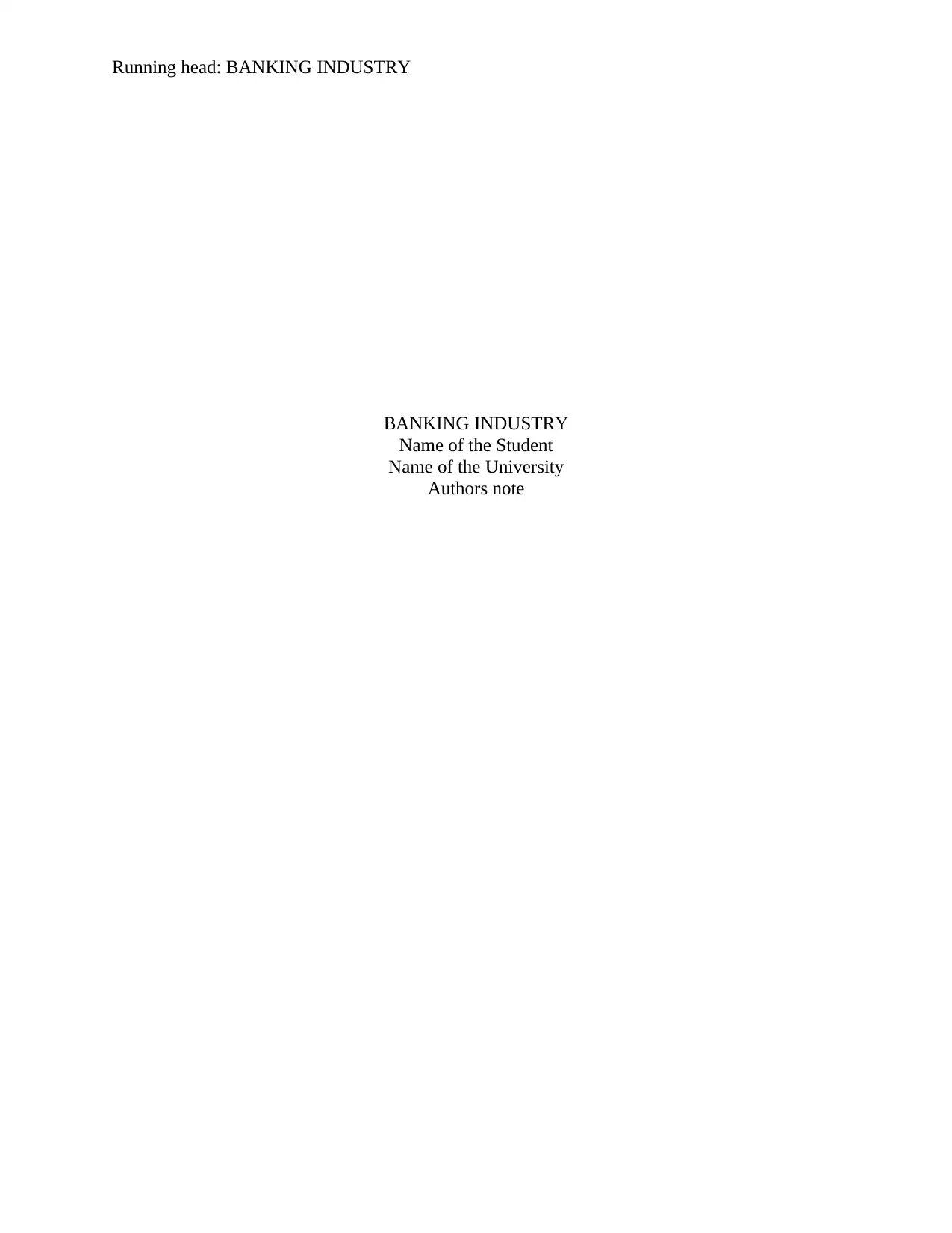
Running head: BANKING INDUSTRY
BANKING INDUSTRY
Name of the Student
Name of the University
Authors note
BANKING INDUSTRY
Name of the Student
Name of the University
Authors note
Paraphrase This Document
Need a fresh take? Get an instant paraphrase of this document with our AI Paraphraser
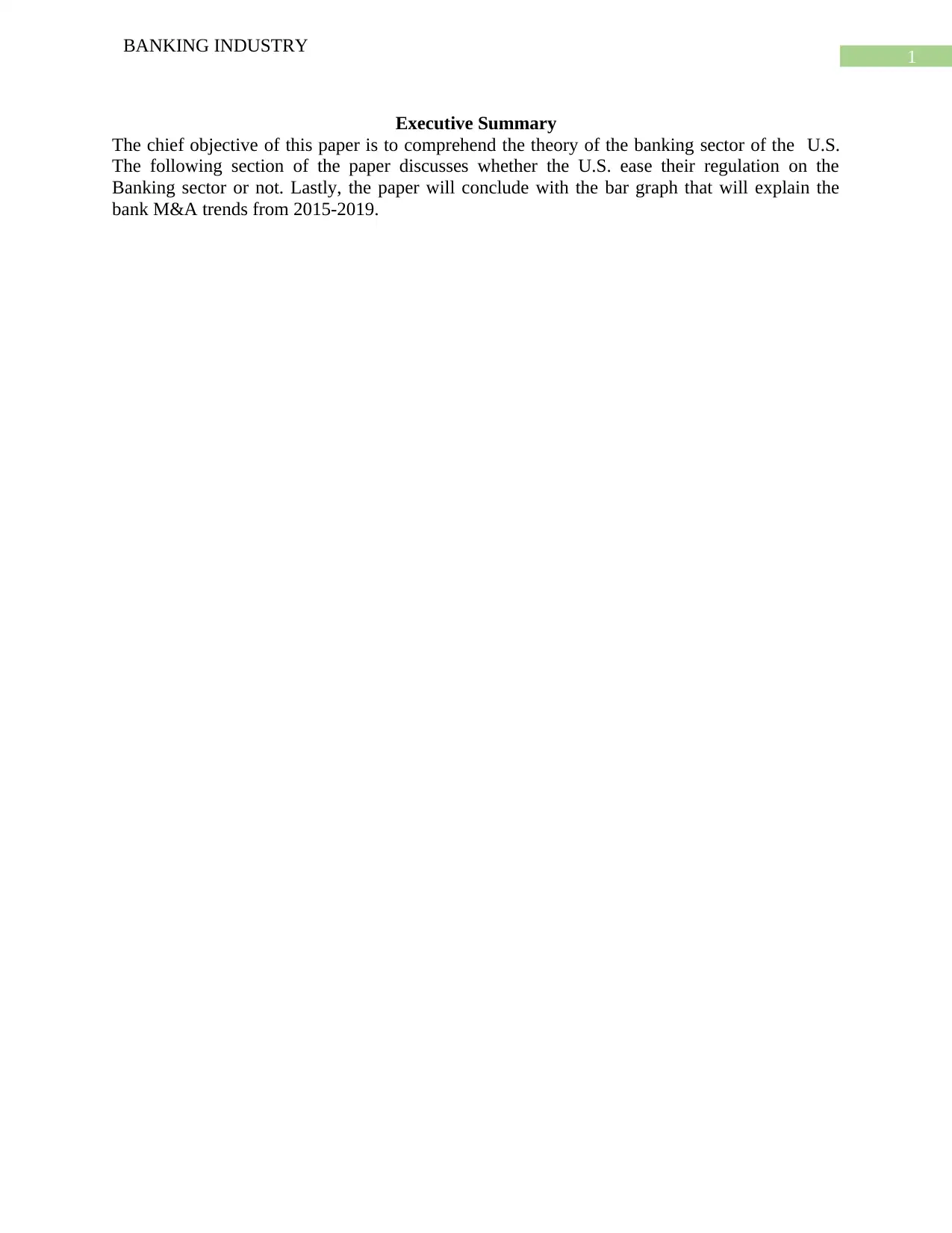
1
BANKING INDUSTRY
Executive Summary
The chief objective of this paper is to comprehend the theory of the banking sector of the U.S.
The following section of the paper discusses whether the U.S. ease their regulation on the
Banking sector or not. Lastly, the paper will conclude with the bar graph that will explain the
bank M&A trends from 2015-2019.
BANKING INDUSTRY
Executive Summary
The chief objective of this paper is to comprehend the theory of the banking sector of the U.S.
The following section of the paper discusses whether the U.S. ease their regulation on the
Banking sector or not. Lastly, the paper will conclude with the bar graph that will explain the
bank M&A trends from 2015-2019.
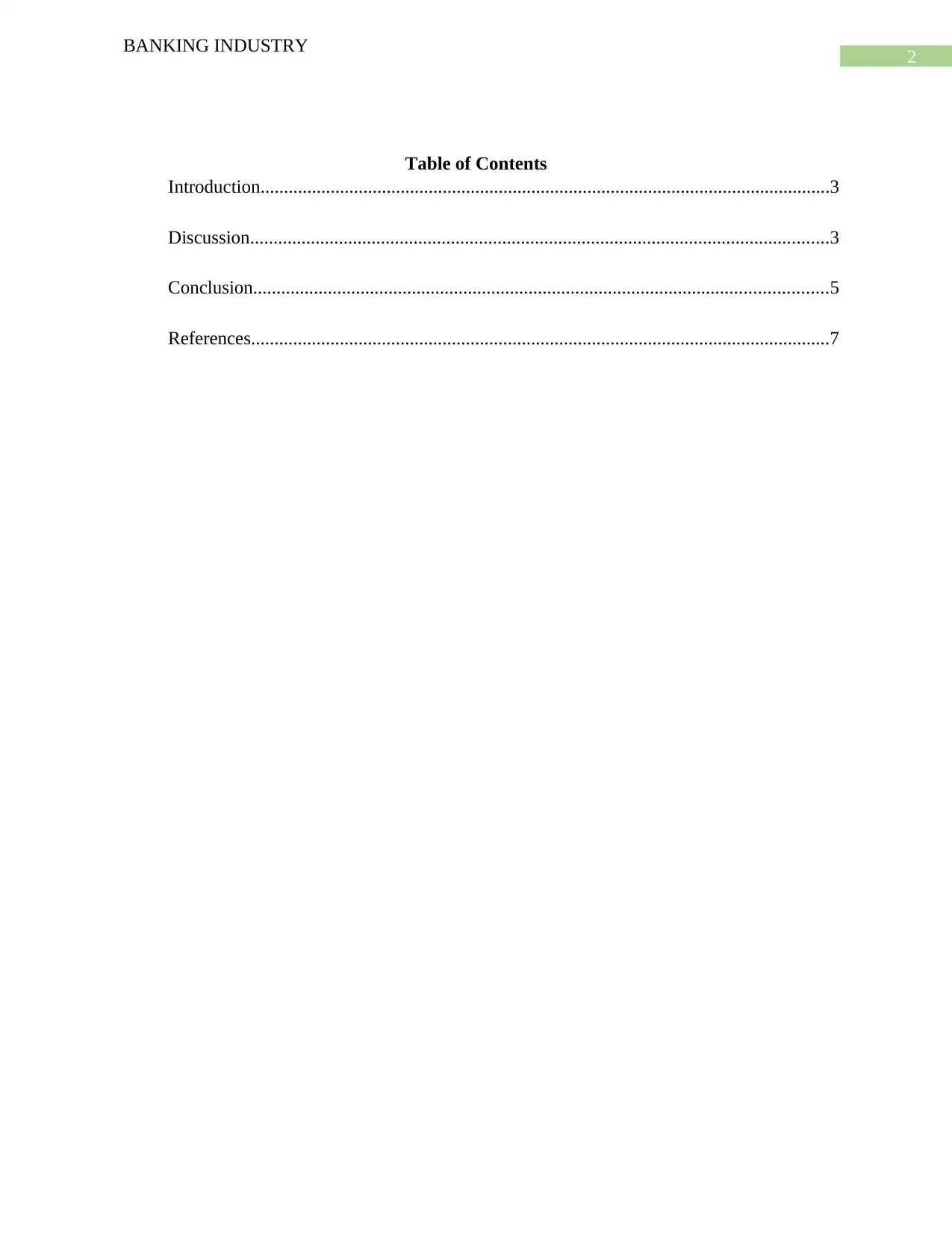
2
BANKING INDUSTRY
Table of Contents
Introduction..........................................................................................................................3
Discussion............................................................................................................................3
Conclusion...........................................................................................................................5
References............................................................................................................................7
BANKING INDUSTRY
Table of Contents
Introduction..........................................................................................................................3
Discussion............................................................................................................................3
Conclusion...........................................................................................................................5
References............................................................................................................................7
⊘ This is a preview!⊘
Do you want full access?
Subscribe today to unlock all pages.

Trusted by 1+ million students worldwide
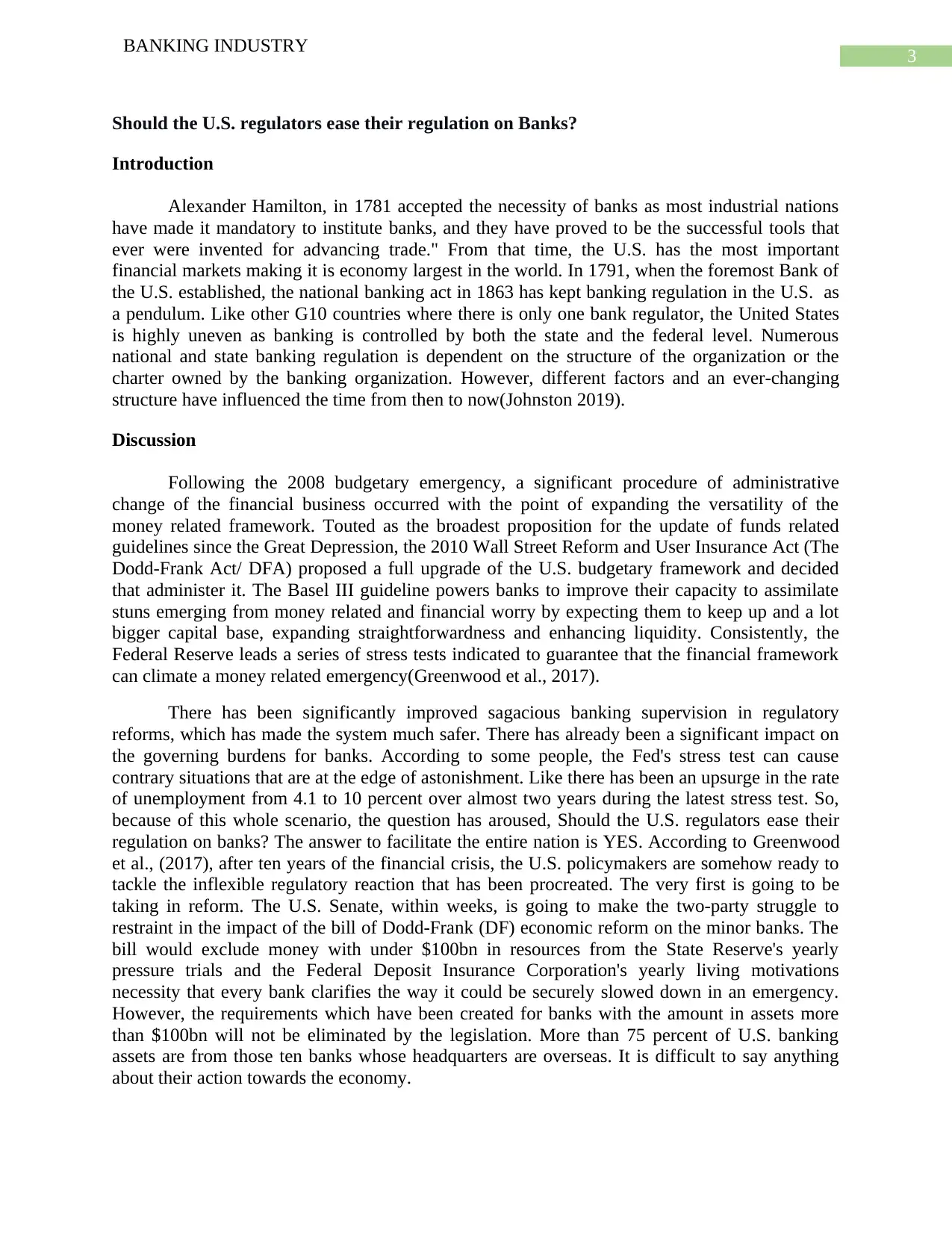
3
BANKING INDUSTRY
Should the U.S. regulators ease their regulation on Banks?
Introduction
Alexander Hamilton, in 1781 accepted the necessity of banks as most industrial nations
have made it mandatory to institute banks, and they have proved to be the successful tools that
ever were invented for advancing trade." From that time, the U.S. has the most important
financial markets making it is economy largest in the world. In 1791, when the foremost Bank of
the U.S. established, the national banking act in 1863 has kept banking regulation in the U.S. as
a pendulum. Like other G10 countries where there is only one bank regulator, the United States
is highly uneven as banking is controlled by both the state and the federal level. Numerous
national and state banking regulation is dependent on the structure of the organization or the
charter owned by the banking organization. However, different factors and an ever-changing
structure have influenced the time from then to now(Johnston 2019).
Discussion
Following the 2008 budgetary emergency, a significant procedure of administrative
change of the financial business occurred with the point of expanding the versatility of the
money related framework. Touted as the broadest proposition for the update of funds related
guidelines since the Great Depression, the 2010 Wall Street Reform and User Insurance Act (The
Dodd-Frank Act/ DFA) proposed a full upgrade of the U.S. budgetary framework and decided
that administer it. The Basel III guideline powers banks to improve their capacity to assimilate
stuns emerging from money related and financial worry by expecting them to keep up and a lot
bigger capital base, expanding straightforwardness and enhancing liquidity. Consistently, the
Federal Reserve leads a series of stress tests indicated to guarantee that the financial framework
can climate a money related emergency(Greenwood et al., 2017).
There has been significantly improved sagacious banking supervision in regulatory
reforms, which has made the system much safer. There has already been a significant impact on
the governing burdens for banks. According to some people, the Fed's stress test can cause
contrary situations that are at the edge of astonishment. Like there has been an upsurge in the rate
of unemployment from 4.1 to 10 percent over almost two years during the latest stress test. So,
because of this whole scenario, the question has aroused, Should the U.S. regulators ease their
regulation on banks? The answer to facilitate the entire nation is YES. According to Greenwood
et al., (2017), after ten years of the financial crisis, the U.S. policymakers are somehow ready to
tackle the inflexible regulatory reaction that has been procreated. The very first is going to be
taking in reform. The U.S. Senate, within weeks, is going to make the two-party struggle to
restraint in the impact of the bill of Dodd-Frank (DF) economic reform on the minor banks. The
bill would exclude money with under $100bn in resources from the State Reserve's yearly
pressure trials and the Federal Deposit Insurance Corporation's yearly living motivations
necessity that every bank clarifies the way it could be securely slowed down in an emergency.
However, the requirements which have been created for banks with the amount in assets more
than $100bn will not be eliminated by the legislation. More than 75 percent of U.S. banking
assets are from those ten banks whose headquarters are overseas. It is difficult to say anything
about their action towards the economy.
BANKING INDUSTRY
Should the U.S. regulators ease their regulation on Banks?
Introduction
Alexander Hamilton, in 1781 accepted the necessity of banks as most industrial nations
have made it mandatory to institute banks, and they have proved to be the successful tools that
ever were invented for advancing trade." From that time, the U.S. has the most important
financial markets making it is economy largest in the world. In 1791, when the foremost Bank of
the U.S. established, the national banking act in 1863 has kept banking regulation in the U.S. as
a pendulum. Like other G10 countries where there is only one bank regulator, the United States
is highly uneven as banking is controlled by both the state and the federal level. Numerous
national and state banking regulation is dependent on the structure of the organization or the
charter owned by the banking organization. However, different factors and an ever-changing
structure have influenced the time from then to now(Johnston 2019).
Discussion
Following the 2008 budgetary emergency, a significant procedure of administrative
change of the financial business occurred with the point of expanding the versatility of the
money related framework. Touted as the broadest proposition for the update of funds related
guidelines since the Great Depression, the 2010 Wall Street Reform and User Insurance Act (The
Dodd-Frank Act/ DFA) proposed a full upgrade of the U.S. budgetary framework and decided
that administer it. The Basel III guideline powers banks to improve their capacity to assimilate
stuns emerging from money related and financial worry by expecting them to keep up and a lot
bigger capital base, expanding straightforwardness and enhancing liquidity. Consistently, the
Federal Reserve leads a series of stress tests indicated to guarantee that the financial framework
can climate a money related emergency(Greenwood et al., 2017).
There has been significantly improved sagacious banking supervision in regulatory
reforms, which has made the system much safer. There has already been a significant impact on
the governing burdens for banks. According to some people, the Fed's stress test can cause
contrary situations that are at the edge of astonishment. Like there has been an upsurge in the rate
of unemployment from 4.1 to 10 percent over almost two years during the latest stress test. So,
because of this whole scenario, the question has aroused, Should the U.S. regulators ease their
regulation on banks? The answer to facilitate the entire nation is YES. According to Greenwood
et al., (2017), after ten years of the financial crisis, the U.S. policymakers are somehow ready to
tackle the inflexible regulatory reaction that has been procreated. The very first is going to be
taking in reform. The U.S. Senate, within weeks, is going to make the two-party struggle to
restraint in the impact of the bill of Dodd-Frank (DF) economic reform on the minor banks. The
bill would exclude money with under $100bn in resources from the State Reserve's yearly
pressure trials and the Federal Deposit Insurance Corporation's yearly living motivations
necessity that every bank clarifies the way it could be securely slowed down in an emergency.
However, the requirements which have been created for banks with the amount in assets more
than $100bn will not be eliminated by the legislation. More than 75 percent of U.S. banking
assets are from those ten banks whose headquarters are overseas. It is difficult to say anything
about their action towards the economy.
Paraphrase This Document
Need a fresh take? Get an instant paraphrase of this document with our AI Paraphraser

4
BANKING INDUSTRY
More economy can be generated if some simple small steps are considered to free big
banks. Even there is no need to wait for legislation by the bank regulators and the supervisors.
The actual binding agent between the bank capital and lending is the Fed's stress test. The need
to give evidence to the banks that any critical situation can be survived without disturbing the
requirements of global capital. Two significant defects are noticed in this process.
The first one is the Fed's worst scenarios leading to Skepticism. Like, in accordance to
the latest stress tests, in seven quarters, the unemployment rate has transferred to 10 percent from
4.1. This is the first time in the past 70 years since now, the measures for joblessness were
implemented. Not the general public, no expert can put their opinion against these scenarios. No
consultancy is taken from the skilled and knowledgeable people of the industry. Now, the
question arises, do we need to save enough money in banks for the events which have no history
or examples in the times past of the U.S.? In the occurrence of any such worst-case scenario, will
the amount of money be more than enough to control the panic among people because of such
extreme economic events?
Now, the second problem, the bank loss, can only be predicted by the Fed's stress tests,
which are dependent on financial representations of secret government. The public analysis can
never uphold these models as there is no way to gain knowledge of their accurateness and well
justification. By contrast, it is allowed to lenders by England's bank to model their fatalities and
then make a comparison between their models or the versions of the models. Permission can be
granted if the differences are reasonable. In this scenario, no concept of 'model monoculture' is
adopted. So, every bank can adapt its holdings to make sure to pass the test and ending up by
holding assets government model favors. It is not easy to predict the risk, so diversity of bank
strategies is preferred.
The living wills process needs money with more than the worth of $50bn in advantages
for grasping the least measures of "harmless" resources; right now, this reserve adds up to more
than $4tn in government obligation, substantially more than called for by the worldwide
guidelines. As the requirement of the individual bank is top-secret and private, so it is not easy to
inform the excessive need of any bank. If this is not checked or noticed, this calls an utterly
random action from the government.
Lending and economic growth are reduced because of the requirements of the higher
bank capital. According to a recent Fed paper, a one percent increase in the capital ratio can
lower the level of long-run GDP growth by 7.4 points. Without knowing an undisclosed model's
affectivity on the capital requirement, it is not easy to judge or estimate the assets through which
the economy is restricted. The more direct effect on lending is due to high liquidity standards.
To make more capital standards and to set liquidity, a more transparent process is not
possible. The recommendations should be followed by the Fed, FDIC, and other bank regulators.
Strong leadership is the core object on which meaningful banking reforms can depend. It will be
unusual, but worth it during change.
It never happened in the big banks of the U.S. but never happened before doesn't mean it
can never happen. Prof Scott is right in his thinking that bank lending will be affected negatively
because of increased capital requirements. Meanwhile, Satoshi Kawazoe gives his opinion from
BANKING INDUSTRY
More economy can be generated if some simple small steps are considered to free big
banks. Even there is no need to wait for legislation by the bank regulators and the supervisors.
The actual binding agent between the bank capital and lending is the Fed's stress test. The need
to give evidence to the banks that any critical situation can be survived without disturbing the
requirements of global capital. Two significant defects are noticed in this process.
The first one is the Fed's worst scenarios leading to Skepticism. Like, in accordance to
the latest stress tests, in seven quarters, the unemployment rate has transferred to 10 percent from
4.1. This is the first time in the past 70 years since now, the measures for joblessness were
implemented. Not the general public, no expert can put their opinion against these scenarios. No
consultancy is taken from the skilled and knowledgeable people of the industry. Now, the
question arises, do we need to save enough money in banks for the events which have no history
or examples in the times past of the U.S.? In the occurrence of any such worst-case scenario, will
the amount of money be more than enough to control the panic among people because of such
extreme economic events?
Now, the second problem, the bank loss, can only be predicted by the Fed's stress tests,
which are dependent on financial representations of secret government. The public analysis can
never uphold these models as there is no way to gain knowledge of their accurateness and well
justification. By contrast, it is allowed to lenders by England's bank to model their fatalities and
then make a comparison between their models or the versions of the models. Permission can be
granted if the differences are reasonable. In this scenario, no concept of 'model monoculture' is
adopted. So, every bank can adapt its holdings to make sure to pass the test and ending up by
holding assets government model favors. It is not easy to predict the risk, so diversity of bank
strategies is preferred.
The living wills process needs money with more than the worth of $50bn in advantages
for grasping the least measures of "harmless" resources; right now, this reserve adds up to more
than $4tn in government obligation, substantially more than called for by the worldwide
guidelines. As the requirement of the individual bank is top-secret and private, so it is not easy to
inform the excessive need of any bank. If this is not checked or noticed, this calls an utterly
random action from the government.
Lending and economic growth are reduced because of the requirements of the higher
bank capital. According to a recent Fed paper, a one percent increase in the capital ratio can
lower the level of long-run GDP growth by 7.4 points. Without knowing an undisclosed model's
affectivity on the capital requirement, it is not easy to judge or estimate the assets through which
the economy is restricted. The more direct effect on lending is due to high liquidity standards.
To make more capital standards and to set liquidity, a more transparent process is not
possible. The recommendations should be followed by the Fed, FDIC, and other bank regulators.
Strong leadership is the core object on which meaningful banking reforms can depend. It will be
unusual, but worth it during change.
It never happened in the big banks of the U.S. but never happened before doesn't mean it
can never happen. Prof Scott is right in his thinking that bank lending will be affected negatively
because of increased capital requirements. Meanwhile, Satoshi Kawazoe gives his opinion from
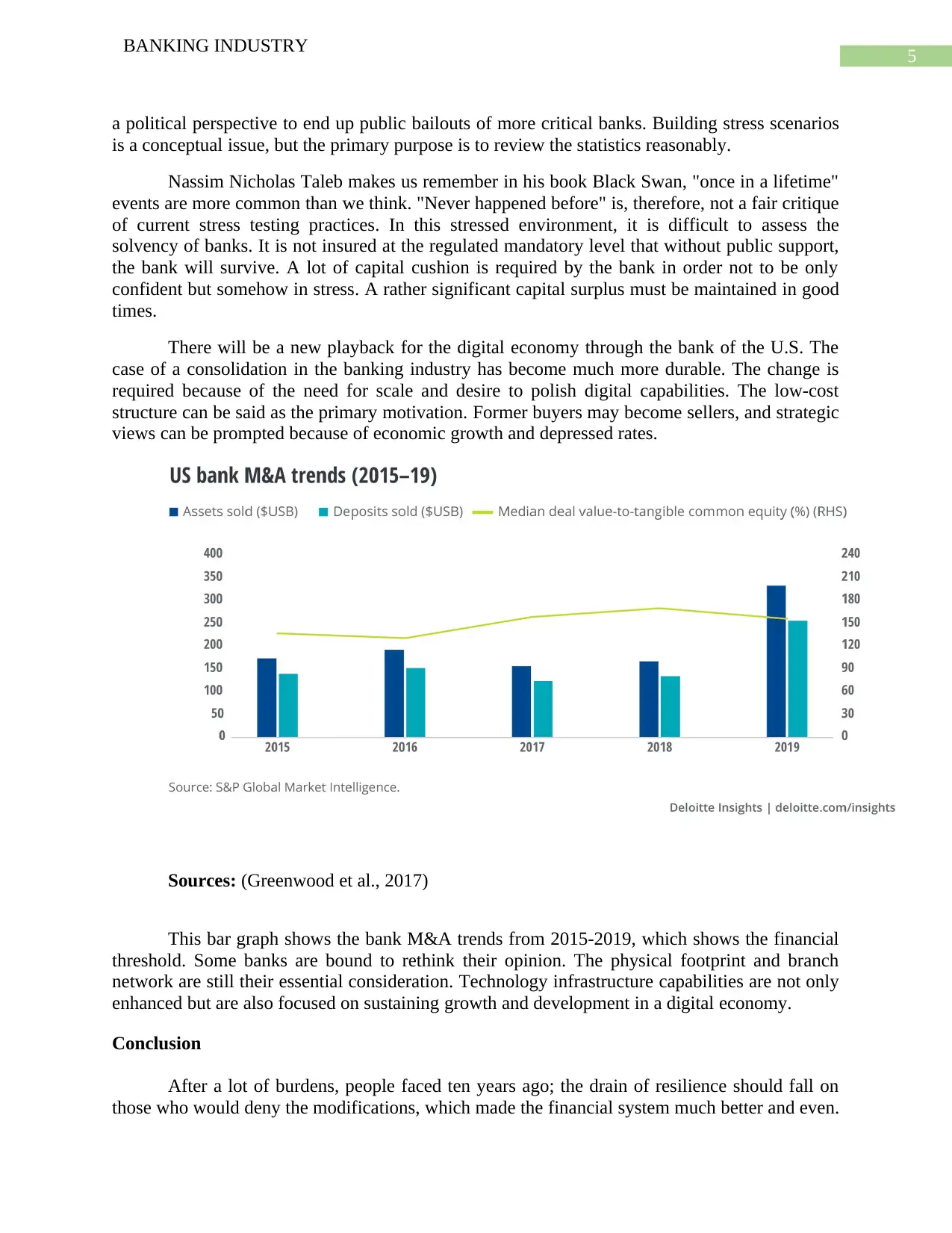
5
BANKING INDUSTRY
a political perspective to end up public bailouts of more critical banks. Building stress scenarios
is a conceptual issue, but the primary purpose is to review the statistics reasonably.
Nassim Nicholas Taleb makes us remember in his book Black Swan, "once in a lifetime"
events are more common than we think. "Never happened before" is, therefore, not a fair critique
of current stress testing practices. In this stressed environment, it is difficult to assess the
solvency of banks. It is not insured at the regulated mandatory level that without public support,
the bank will survive. A lot of capital cushion is required by the bank in order not to be only
confident but somehow in stress. A rather significant capital surplus must be maintained in good
times.
There will be a new playback for the digital economy through the bank of the U.S. The
case of a consolidation in the banking industry has become much more durable. The change is
required because of the need for scale and desire to polish digital capabilities. The low-cost
structure can be said as the primary motivation. Former buyers may become sellers, and strategic
views can be prompted because of economic growth and depressed rates.
Sources: (Greenwood et al., 2017)
This bar graph shows the bank M&A trends from 2015-2019, which shows the financial
threshold. Some banks are bound to rethink their opinion. The physical footprint and branch
network are still their essential consideration. Technology infrastructure capabilities are not only
enhanced but are also focused on sustaining growth and development in a digital economy.
Conclusion
After a lot of burdens, people faced ten years ago; the drain of resilience should fall on
those who would deny the modifications, which made the financial system much better and even.
BANKING INDUSTRY
a political perspective to end up public bailouts of more critical banks. Building stress scenarios
is a conceptual issue, but the primary purpose is to review the statistics reasonably.
Nassim Nicholas Taleb makes us remember in his book Black Swan, "once in a lifetime"
events are more common than we think. "Never happened before" is, therefore, not a fair critique
of current stress testing practices. In this stressed environment, it is difficult to assess the
solvency of banks. It is not insured at the regulated mandatory level that without public support,
the bank will survive. A lot of capital cushion is required by the bank in order not to be only
confident but somehow in stress. A rather significant capital surplus must be maintained in good
times.
There will be a new playback for the digital economy through the bank of the U.S. The
case of a consolidation in the banking industry has become much more durable. The change is
required because of the need for scale and desire to polish digital capabilities. The low-cost
structure can be said as the primary motivation. Former buyers may become sellers, and strategic
views can be prompted because of economic growth and depressed rates.
Sources: (Greenwood et al., 2017)
This bar graph shows the bank M&A trends from 2015-2019, which shows the financial
threshold. Some banks are bound to rethink their opinion. The physical footprint and branch
network are still their essential consideration. Technology infrastructure capabilities are not only
enhanced but are also focused on sustaining growth and development in a digital economy.
Conclusion
After a lot of burdens, people faced ten years ago; the drain of resilience should fall on
those who would deny the modifications, which made the financial system much better and even.
⊘ This is a preview!⊘
Do you want full access?
Subscribe today to unlock all pages.

Trusted by 1+ million students worldwide
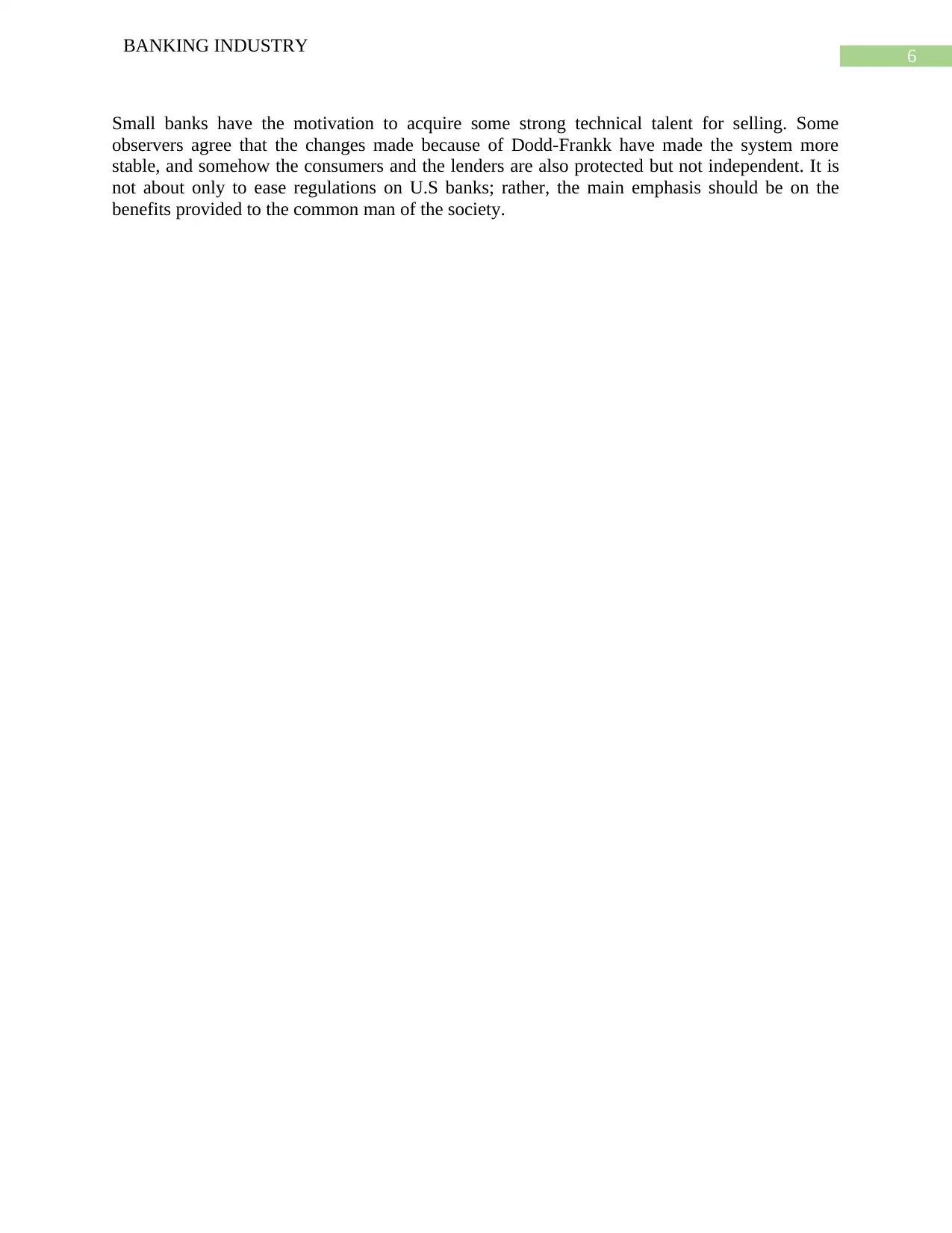
6
BANKING INDUSTRY
Small banks have the motivation to acquire some strong technical talent for selling. Some
observers agree that the changes made because of Dodd-Frankk have made the system more
stable, and somehow the consumers and the lenders are also protected but not independent. It is
not about only to ease regulations on U.S banks; rather, the main emphasis should be on the
benefits provided to the common man of the society.
BANKING INDUSTRY
Small banks have the motivation to acquire some strong technical talent for selling. Some
observers agree that the changes made because of Dodd-Frankk have made the system more
stable, and somehow the consumers and the lenders are also protected but not independent. It is
not about only to ease regulations on U.S banks; rather, the main emphasis should be on the
benefits provided to the common man of the society.
Paraphrase This Document
Need a fresh take? Get an instant paraphrase of this document with our AI Paraphraser

7
BANKING INDUSTRY
References
Johnston, M., 2019. A Brief History of U.S. Banking Regulation.
Greenwood, R., Hanson, S.G., Stein, J.C. and Sunderam, A., 2017. The financial regulatory
reform agenda in 2017. Project on Behavioral Finance and Financial Stability Working Paper, 9.
BANKING INDUSTRY
References
Johnston, M., 2019. A Brief History of U.S. Banking Regulation.
Greenwood, R., Hanson, S.G., Stein, J.C. and Sunderam, A., 2017. The financial regulatory
reform agenda in 2017. Project on Behavioral Finance and Financial Stability Working Paper, 9.
1 out of 8
Related Documents
Your All-in-One AI-Powered Toolkit for Academic Success.
+13062052269
info@desklib.com
Available 24*7 on WhatsApp / Email
![[object Object]](/_next/static/media/star-bottom.7253800d.svg)
Unlock your academic potential
© 2024 | Zucol Services PVT LTD | All rights reserved.





